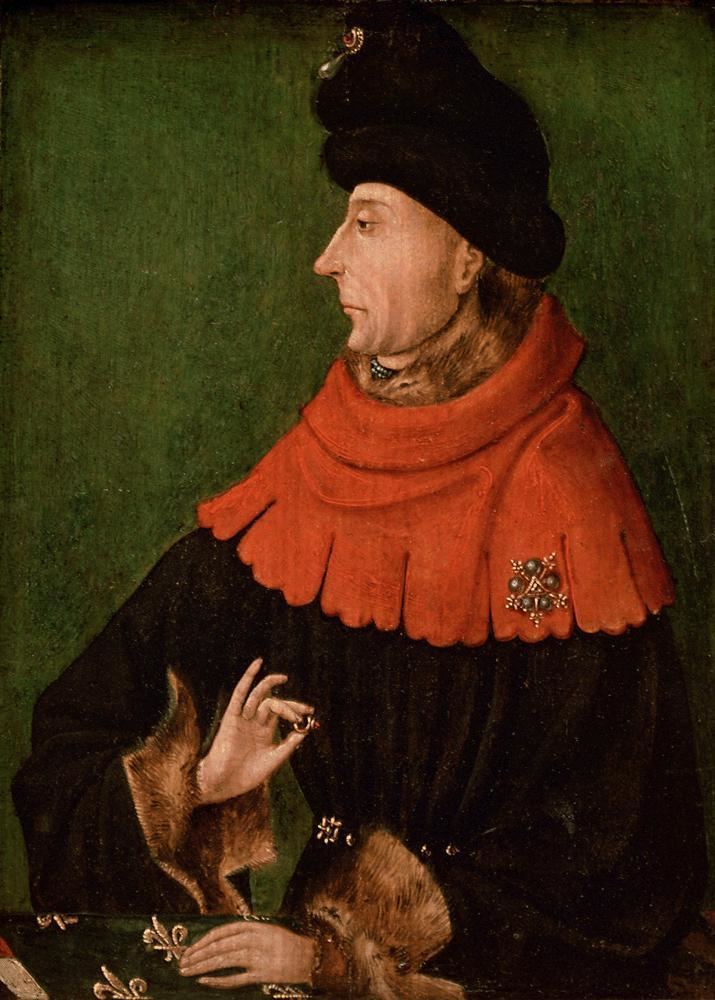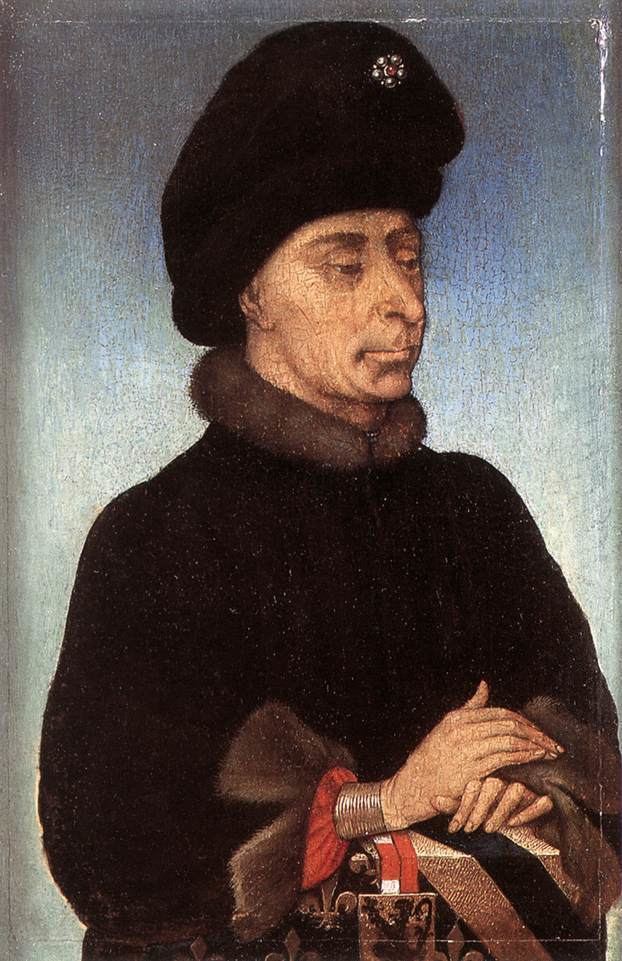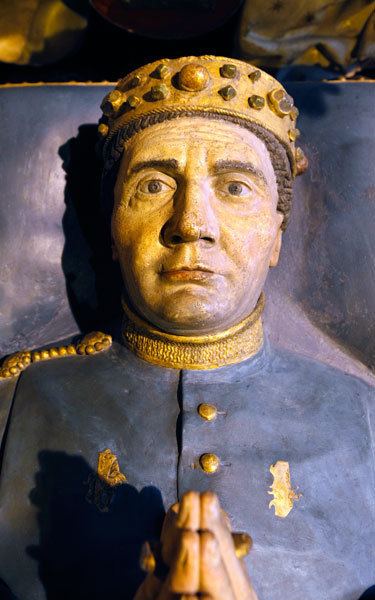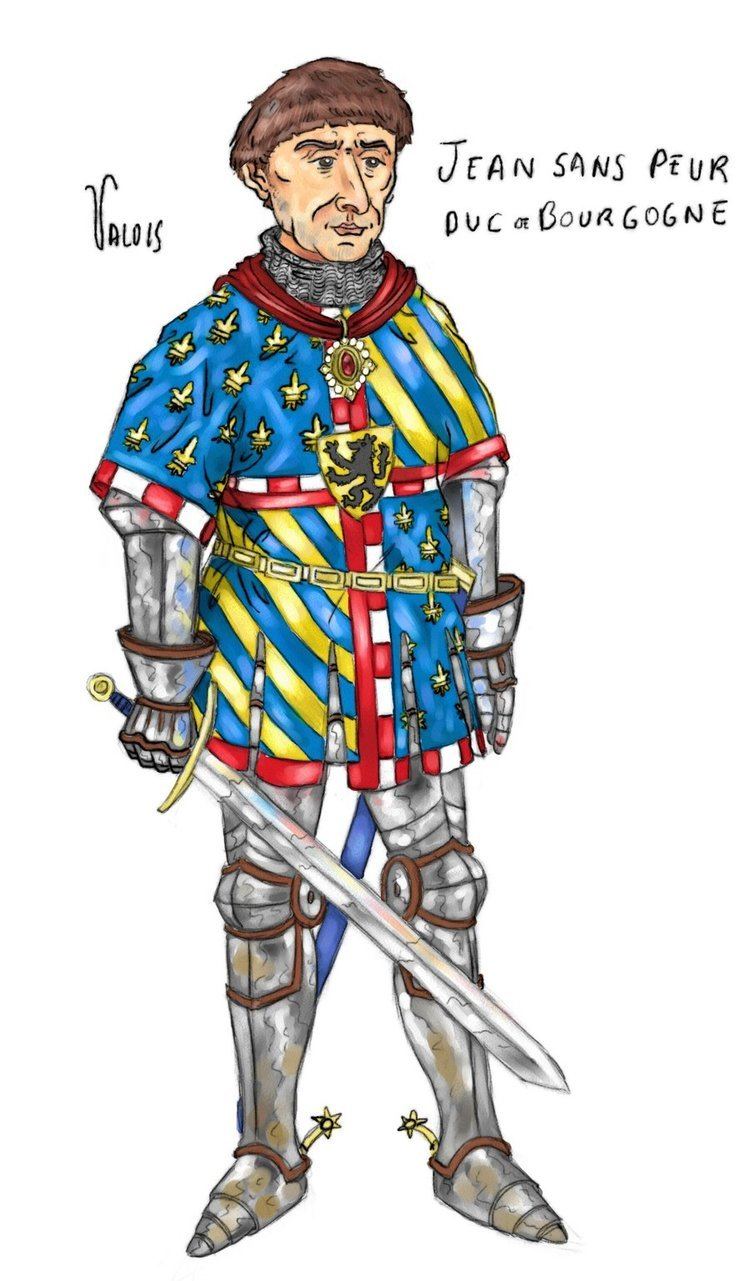Name John Fearless | Children Philip the Good | |
 | ||
Reign 27 April 1404–10 September 1419 Issue Mary, Duchess of ClevesMargaret, Dauphine of FrancePhilip III the GoodIsabelle, Countess of PenthievreAnne, Duchess of BedfordAgnes, Duchess of Bourbon Parents Philip the Bold, Margaret III, Countess of Flanders Similar People | ||
John the Fearless (French: Jean sans Peur, Dutch: Jan zonder Vrees), also known as John of Valois and John I of Burgundy (28 May 1371 – 10 September 1419), was Duke of Burgundy from 1404 to 1419. He was a member of the Burgundian branch of the Valois Dynasty. For a period of time, he served as regent of France on behalf of his first cousin King Charles VI of France, who was severely mentally ill.
Contents
- Jan zonder vrees be nl john the fearless 1984
- Early life
- Conflict with Louis of Orlans
- Conflict with the Dauphin
- Family
- Titles
- References

Jan zonder vrees be nl john the fearless 1984
Early life

John was born in Dijon on 27 May 1371 to Philip II "the Bold," Duke of Burgundy, and Margaret III, Countess of Flanders. On the death of his maternal grandfather Louis II, Count of Flanders, in 1384, he received the title Count of Nevers, which he bore until his father’s death in 1404, when he ceded it to his brother Philip.

In 1385, a double wedding for the Burgundian family took place in Cambrai. John married Margaret of Bavaria, daughter of Albrecht of Bavaria, Count of Holland and Hainaut, while at the same time his sister Margaret of Burgundy married Albrecht's son William in order to consolidate John's position in the Low Countries. The marriage took place after John cancelled his engagement to Catherine of France, a daughter of King Charles V of France who was only a child at the time.

Before his accession to the Duchy of Burgundy, John was one of the principal leaders of the French forces sent to aid King Sigismund of Hungary in his war against Sultan Bayezid I. John fought in the Battle of Nicopolis of 25 September 1396 with such enthusiasm and bravery that he was given the cognomen Fearless (Sans-Peur). Despite his personal bravery, his impetuous leadership ended in disaster for the European expedition. He was captured and did not recover his liberty until the next year after an enormous ransom was paid.
Conflict with Louis of Orléans
John was invested as Duke of Burgundy in 1404 upon the death of his father Philip the Bold and almost immediately entered into open conflict with Louis, Duke of Orléans, the younger brother of the increasingly disturbed King Charles VI of France. Both men attempted to fill the power vacuum left by the demented king.
John played a game of marriages by exchanging his daughter Margaret of Burgundy for Michelle of Valois, who would marry his heir, Philip the Good. For her part, Margaret was married to Louis, Duke of Guyenne, the heir to the French throne from 1401 until his death in 1415. For all his concentration on aristocratic politics, John nonetheless did not overlook the importance of the middle class of merchants and tradesman or the University of Paris.
Louis tried to gain the favour of the wife of Charles VI, Queen Isabeau of France, and may have become her lover. After his son-in-law, the Dauphin Louis, was successively kidnapped and recovered by both parties, the Duke of Burgundy managed to gain appointment by royal decree — during one of the King's "absent" periods when mental illness manifested itself — as guardian of the Dauphin and the King's children. This did not improve relations between John and the Duke of Orléans. Soon the two rivals descended into making open threats. Their uncle, John, Duke of Berry, secured a vow of solemn reconciliation on 20 November 1407, but only three days later, on 23 November 1407, Louis was brutally assassinated in the streets of Paris. The order, no one doubted, had come from the Duke of Burgundy, who shortly admitted to the deed and declared it to be a justifiable act of "tyrannicide". According to Thomas Walsingham, Orléans had simply received his just deserts as he had been "taking his pleasure with whores, harlots, incest" and had committed adultery with the wife of an unnamed knight who had taken his revenge by killing him under the protection of the Duke of Burgundy. After an escape from Paris and a few skirmishes against the Orléans party, John managed to recover the King's favour. In the treaty of Chartres, signed on 9 March 1409, the King absolved the Duke of Burgundy of the crime, and he and Louis' son Charles pledged a reconciliation. A later edict renewed John's guardianship of the Dauphin.
Even with the Orléans dispute resolved in his favour, John did not lead a tranquil life. Charles, the son and heir of the murdered Duke of Orleans, was only 14 at the time of his father's death and was forced to depend heavily on allies to support his claims for the property that had been confiscated from him by the Duke of Burgundy. Chief among these allies was his father-in-law Bernard VII, Count of Armagnac. Because of this alliance, their faction became known as the Armagnacs in opposition to the Burgundians. With peace between the factions solemnly sworn in 1410, John returned to Burgundy and Bernard remained in Paris, where he reportedly shared the Queen's bed. The Armagnac party was not content with its level of political power, and after a series of riots and attacks against the citizens, John was recalled to the capital, then sent back to Burgundy in 1413. At this time, King Henry V of England invaded French territory and threatened to attack Paris. During the peace negotiations with the Armagnacs, Henry was also in contact with John, who was keen to wrest control of France away from King Charles VI. Despite this, he continued to be wary of forming an alliance with the English for fear of destroying his immense popularity with the common people of France. When Henry demanded Burgundy's support for his claim to be the rightful King of France, John backed away and decided to ally himself with the Armagnacs. Although he talked of helping his sovereign, his troops took no part in the Battle of Agincourt in 1415, although two of his brothers, Antoine, Duke of Brabant, and Philip II, Count of Nevers, died fighting for France during the battle.
Conflict with the Dauphin
Two years later, with the rivalry between Burgundians and Armagnacs at an all-time high because of the shattering defeat at Agincourt, John's troops set about the task of capturing Paris. On 30 May 1418, he did capture the city, but not before the new Dauphin, the future Charles VII of France, had escaped. John then installed himself in Paris and made himself protector of the King. Although not an open ally of the English, John did nothing to prevent the surrender of Rouen in 1419. With the whole of northern France in English hands and Paris occupied by Burgundy, the Dauphin tried to bring about a reconciliation with John. They met in July and swore peace on the bridge of Pouilly, near Melun. On the grounds that peace was not sufficiently assured by the meeting at Pouilly, a fresh interview was proposed by the Dauphin to take place on 10 September 1419 on the bridge at Montereau. John of Burgundy was present with his escort for what he considered a diplomatic meeting. He was, however, assassinated by the Dauphin's companions. He was later buried in Dijon. His successor Philip the Good formed an alliance with the English.
Family
John and his wife Margaret, who married in 1385, had one son, who succeeded him, and seven daughters:
John and his mistress Agnes de Croy, daughter of Jean I de Croÿ, had the following child:
John and his mistress Marguerite de Borsele had the following children:
